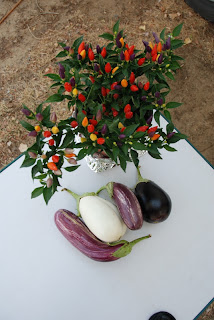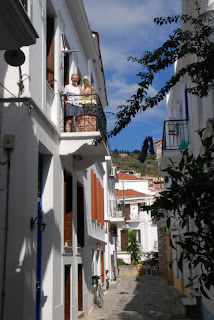We woke up
feeling cold, something that we haven't felt for months. Getting up
to make the tea I checked the outside temperature, it was under 2°C
and the inside temperature was only 6°C.
I put the heating on! It was 28°C
during the day in Alexandropolis and now under 2°C
– what a contrast.
We had long day of
driving today but not as long or as frenetic as yesterday. Continuing
south on the 750 we came across a large number of stalls on both
sides of the road selling melons, many hundreds on each stall and of
four of five different varieties. We soon came to the town of Kazan
which we christened 'Melon City' and the locals obviously thought the
same as, in pride of place, on a plinth in the centre of the town was
a massive sculpture of a melon.
The stalls continued
for a long distance after the town before we arrived at the motorway
ring road around Ankara. I was expecting similar road conditions and
driving to the Istanbul motorway but this was much more civilised and
much quieter.
Heading east from
Ankara we passed another melon growing area with many more stalls but
the melons were smaller and not the same quality as Melon City.
By 15:00 we had
arrived at our first destination, Alacahuyuk, a few miles north-east
of Sungurlu. We had come to see evidence of the Hittites, a people
who occupied this part of Turkey and many other lands during the
period 2200 BC to 1183 BC and this was the first of three sites that
we planned to visit.
Alacahuyuk, discovered
in 1835 by the English explorer W. J. Hamilton, was first occupied in
the Copper Age (5,500 – 3,000 BC) but most of the finds relate to
the Hatti civilization, predecessors of the Hittites, who occupied
the site in the Early Bronze Age (3,000 – 2,000 BC) and made it
their capital. However the Hittites took over the site and left their
marks such as the impressive 'Sphinx Door' at the southern gate of
the city. The walled city is quite small and there is little above
ground other than the walls of buildings. However, Alacahuyuk is
famous for its rich Natti royal burials where the bodies were placed
in tombs surrounded by rich grave goods and the skulls and leg bones
of sacrificed animals. Very good reconstructions of the burials have
been placed inside the excavated city, giving the visitor an idea of
the wealth of the Hatti civilization. There is also a small but very
good museum displaying some of the finds.
We drove on using
country roads to our next destination – Bogazkale and Camping
Asikoglu.
It is common in Turkey
for campsites to be associated with a hotel and this is the case with
Camping Asikoglu. We had a good meal in the traditionally furnished
hotel restaurant and our host advised us how to visit Hattusa and
Yazilikaya, the two local sites. He also told us to have as many
apples as we wanted from the trees in the campsite - £10 a night and
free apples, can't be bad!
Photos: Hatti royal burial with sun discs and
sacrificed cattle heads; A Hittite teapot – tea drinking has been a
tradition for thousands of years here!






























